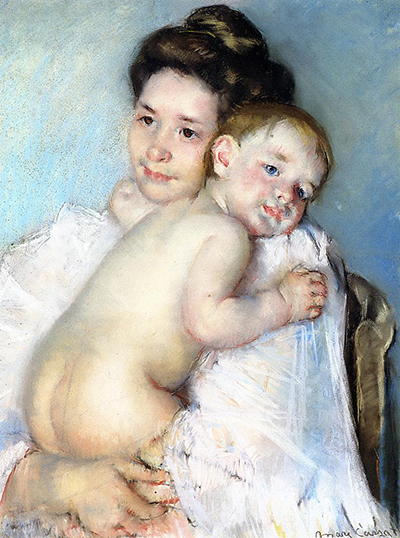The Young Mother (Mother Berthe Holding Her Baby) is a pastel by Mary Cassatt that was completed in around the year 1900, after a series of earlier drypoint prints in preparation for this more detailed piece.
Berthe sits in a smart chair, one side of which we can just make out from the side of her left arm. She wears a delicate white blouse and perhaps a pink dress underneath that just appears in the bottom of the painting, but most of that section is cropped out so it is hard to tell. She is young and particularly pretty, even with the strain of having to look after a young baby. The young mother has very dark eyes, and a matching tone for her hair, which is tidied away to allow her to achieve a pragmatic appearance which reflects her daily tasks. Society was very traditional during the late 19th century and so gender roles were well defined in most cases, though Mary Cassatt was able to challenge those with her own career. Thankfully, things have changed since, and we now see a far greater number of female artists in the mainstream that we would have done around a century ago. Her oeuvre also drew attention to the lives of working women, more so than any mainstream artist had done before.
In recent years there has been a concerted effort to address the imbalance in exhibitions and permanent collections with regards the genders - very few women have been featured and some of those who deserve greater exposure have started to receive it. Cassatt was one of the few women to achieve success and recognition without any help from others, purely through a strength of character and a great mastery of the techniques of painting and drawing. Therefore, when art galleries promote her work they can claim to be doing so out of pure respect rather than trying to pander to some of the social fashions of the day, and, frankly, Cassatt should just be regarded as a great artist, regardless of gender.
This pastel drawing now resides within a private collection and so is rarely accessible to the public. Scenarios like this tend to lead to less information becoming available on the artwork, with private collectors being less willing and able, generally, to spend time and money researching the items in their collection. We probably now more about the study prints that were produced for this piece than this completed artwork, because they have become parts of major gallery collections. The artist's career works have become fairly well dispersed across all manner of places, both geographically, but also between private and public collections. There are, therefore, plenty of opportunity to see her original works whether you live in her native US or in Europe, and this must be a good thing in terms of strengthening her reputation amongst the younger generations who will likely come across some of her paintings and pastels at some point.




